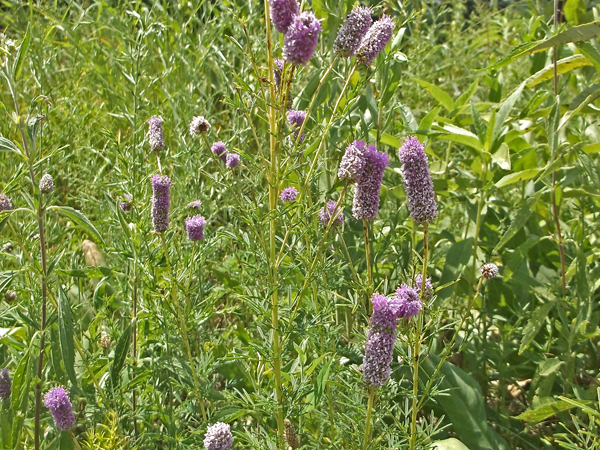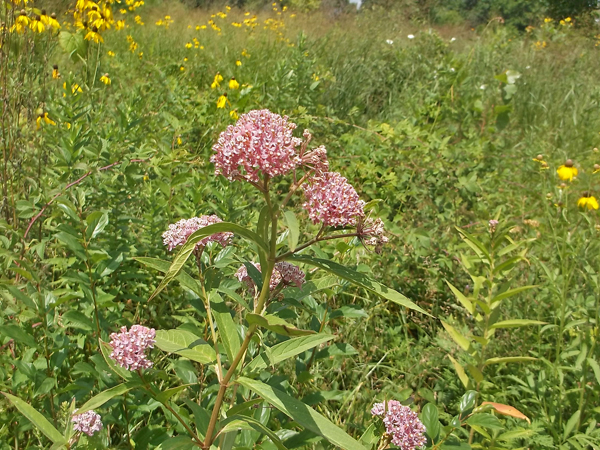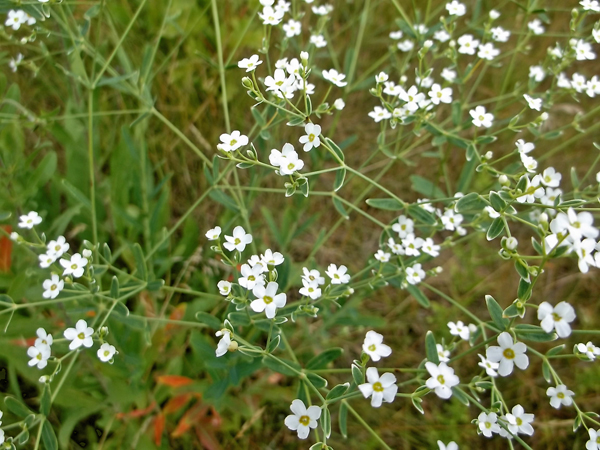The meadow in my backyard is getting better every year. In 2006, just after I moved in, this area was mowed on a weekly basis. I could see, though, that this area was never planted to turf, like the areas closer to the house. There were Pussy Toes blooming in spring, asters, Poverty Oats Grass, Wild Strawberries, and other things just waiting it out – for about 50 years, until I came along. I stopped mowing, herbicided the weeds, and seeded in and planted native tallgrass prairie species.
This past week, the Prairie Blazing Star (Liatris pycnostachya) started blooming. In the photo above, it is blooming with the white flowered Wild Quinine (Parthenocissus quinquefolia) and on the right edge of the photo, Rattlesnake Master (Eryngium yuccifolium) with its strappy, yucca-like leaves. In a few weeks, another blazing star in the meadow will be blooming, Rough Blazing Star (L. aspera).
Almost all of the white in this photo below, is Mountain Mint (Pycnanthemum tenuifolium) mixed into a matrix of Little Bluestem Grass (Schizachyrium scoparium). The tall yellow flowers in the distance are Gray-Headed Coneflowers (Ritibida pinata). Walking through the Mountain Mint is a sensory experience – on a warm summer day, the clean mint smell will rise around you.
Little Bluestem Grass really puts on a show in fall, when the blue-green foliage turns a coppery orange, and stays nice throughout the winter. Even in summer, however, it is an attractive grass, growing to 18 inches high and wide, and a bit taller when it is in flower.
Walking through the meadow, some pretty interesting pollinators were seen, including this Buckeye Butterfly.
Another visitor to the meadow was this Dragonfly, busy sunning itself on a dry twig.
Gray-Headed Coneflower, Wild Quinine, and Prairie Dropseed Grass make for an eye pleasing combination.
Purple Prairie Clover is just about to finish it’s bloom cycle, starting from the bottom up, just the opposite of the blazing star.
The Wild Sweet Potato (Ipomoea pandurata) was rambling over the Buttonbush (Cephalanthus occidentalis). Wild Sweet Potato grows from a large, underground tuber, as you may have guessed from its name. Its vines grow quite a long length in a short time, dying back to the ground each winter. The plant does not spread by roots or seeds, making it a good garden plant, as well.
The large white 3 to 4 inch blooms last only a day each.
Marsh Milkweed (Asclepias incarnata)- shown below- can get 3 to 4 feet tall and wide, sometimes that’s a bit too big for the home garden. Purple Milkweed (A. purpuranscens) is more upright with a less open habit, but similar purple-pink flowers – a better garden plant than Marsh Milkweed.
Gray-Headed Coneflower at the rear of the meadow enjoys its sunny location. Its bright yellow flowers, on 4 foot tall (or more) stalks, can be seen from a long distance away.
On the much shorter side of things (at approximately a foot tall), Partridge Pea (Cassia fasciculata) and the purple flowered Heal-All (Prunella vulgaris) seem to be getting along together, just fine. Partridge Pea generally can be found in colonies while Heal-All is often found singly, and seemingly randomly, throughout an area.
Ironweed (Vernonia fasciculata) has just begun to show some color – with all the yellow flowers in the meadow, this bright royal purple is a welcome addition to the color palette. At 5 feet tall, or more, the flowers can not hardly be missed.
The delicate looking, but quite tough, Flowering Spurge (Euphorbia corollata) makes a great accent plant, and is wonderfully adaptable in the garden, as well as being quite nice here in the meadow. It can take part sun and damp soil, to full sun and dry ground. It has a coarse root system that helps in this durability.
It would look great in any garden – with similar flowering heights, it works well planted with Pale Purple Coneflower (Echinacea pallida). As the coneflowers wane and only the dark seed heads remain, the euphorbia comes on strong, and complements the coarseness of the coneflower.
The Orange Milkweed (Asclepias tuberosa) likes full sun and good drainage. It can be slow to get established, but puts on a great show. A terrific garden plant as well. Its coarse root system can make it a little more difficult to dig and move in the garden, but it can be done, if necessary. Of course butterflies are attracted to milkweeds and Monarchs rely on them to reproduce.
Cup Plant (Silphium perfoliatum) has a great coarse leaves – big and bold, among more modest foliage. The 3 inch bright yellow blooms provide nectar to a host of pollinators.
Cup Plant is true to its name, by holding water at the base if its leaves. Insects and birds will come to drink. And later the birds will fight for the oil rich seeds.
All the flowers and grasses find and make space so that they can put on their best show. The variety of colors and shapes boggles the mind in their diversity. Who could possibly want a lawn of monotony?
The meadow is a colorful place at all times of the year, even in winter with shades of orange, rust, and gold, but summer is simply amazing, not only for the flowers, but all the forms of life that take advantage of the flowers and leaves, seeds and nectar, shelter and perch. Magic … seemingly anyhow.






















